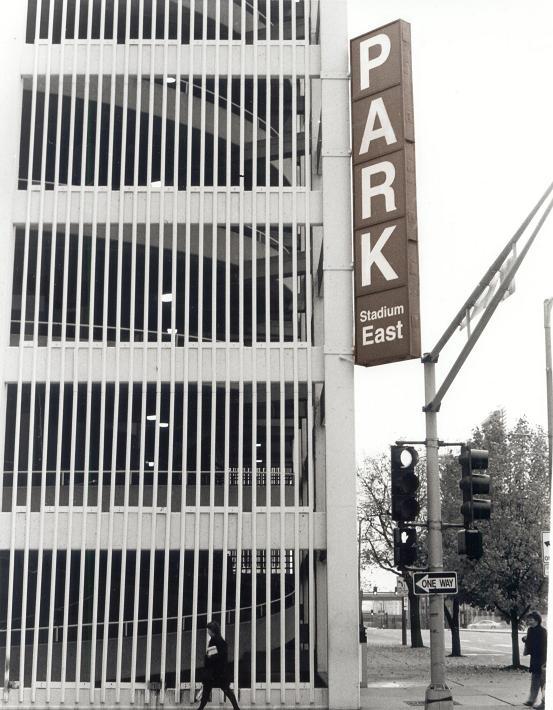The National Building Museum in Washington D.C. is playing host to a fascinating exhibit: the history of parking in the United States.
A Washington Post article on the exhibit pulls out a few interesting, if not altogether surprising points: parking lots used to be rare and parking structures were once given design consideration.
Yet the modern era that emphasized architectural honesty and a bold break from classicism admired the repetitive geometry of the concrete garage. It emboldened architects to highlight, rather than hide, increasingly large structures dedicated to that ultimate symbol of American progress and freedom--the automobile.
From the article:
There was an era, says Sarah Leavitt, curator of the National Building Museum show, when cities took pride in these structures. But that pride, based on the sense that a modern city couldn't progress without adequate parking, hid a darker indifference to the historical fabric of the city. The exhibition also includes before-and-after shots of a block of F Street NW, showing the loss of two historic buildings to a hideous parking garage built next to the Hotel Washington. It also includes an image of one of the most notorious parking garages in the world, the Michigan Theater in Detroit, made by slamming concrete decks into the shell of a classic and beautifully ornamented movie house. To this day, people still park there surrounded by the ghostly architectural shadow of a building once meant to please and delight.
In St. Louis, many of us are well aware of the history of parking. Parking garages--and other autocentric uses such as automobile showrooms--used to be housed in urban, street-fronting buildings. We saw this in the old Livery Stable on Locust in Automobile Row--demolished by SLU in 2007 for, ironically, a surface parking lot.
Livery Stable in the foreground. Photograph courtesy of VanishingSTL, which ran an excellent piece on the Livery Stable demolition here. Note how the Stable contributes to the urban streetscape; now it's a parking superblock.
The modern era in St. Louis was much as described above in the Washington Post article: architects boldly ripped out the historic built environment for oversized concrete garages. Of all the buildings that have been demolished in downtown St. Louis since the 1950s, parking garages are rarely among those targeted (if ever?). Some of downtown's dreariest and most life-sucking uses remain modern-era garages that must come down to create lively streetscapes.
Public Enemy Number One, in my opinion, is the outright hideous and, frankly, embarrassing presence of the Busch Stadium garages.

Who doesn't feel sorry for the pedestrian that has to walk a whole block beneath the hulking presence of one of the Busch Stadium garages? To think that they bookend the proposed Ballpark Village development, too! Clearly, in order to have an active "village-like" atmosphere, these horrific garages should go. Likewise, urbanists often lampoon Kiener Plaza for its supposed lifelessness; yet it's the hideous Kiener garages that flank the civic plaza that lend the space so much drear and droll.
In another urban planning and design disaster, the 1896 Century Building was destroyed to create a parking garage that mocked the original piece of architectural splendor. Detractors rightfully called it "Garage Mahal". This 2004 garage clearly retreated from the attention-grabbing antics of its modern predecessors (if for no other reason than the controversy over the Century demolition). Yet, somehow, its presence is only slightly more "welcoming" than Busch or Keiner.
No, by the way, street-level retail does not always mitigate parking garages ugliness. Something about the permeable nature of garages makes them uncomfortable for the pedestrian; they're open; the wind blows through, as if they were vacant, windowless buildings. Their concrete structures are usually heavy and foreboding; their nightime orange glow menacing.
The saga continues in St. Louis. Instead of getting Pyramid's "Mercantile Exchange" retail district with a restyled St. Louis Centre, we're now getting a
parking garage with street level retail. While this deal may be preferable to a standalone, completely ugly and unadorned parking garage at the old
Ambassador site as was originally proposed to placate downtown lawfirm Thompson Coburn--it's a far cry from good planning. Downtown has too much parking; each garage makes downtown a little less interesting and less walkable.
The history of parking in St. Louis, especially downtown, could have supplied the National Building Museum with plenty of material. Recall that the site of the Gateway Arch sat as a huge surface parking lot for decades (from the early 1940s all the way to the early 1960s), marring the riverfront and totally disrespecting the original site of the colonial city of St. Louis.
Despite lessons learned since then, St. Louis is still building parking garages for each new development, reducing their urban appeal. There's a recently completed garage at Tucker and Clark; look for new ones to rise with the Kiel Opera House redevelopment as well as the Municipal Courts Building. And those are all contiguous blocks.
As I've argued many times on this site, St. Louis needs a parking plan for its downtown and a zoning code that emphasizes the importance of pedestrian activity and safety over that of vehicular ease of access. With sound planning, the "future of parking" should be a much less lengthy story than its past.
























